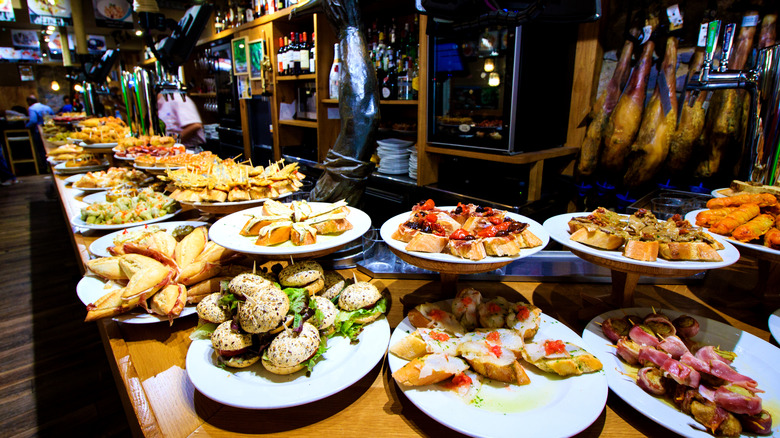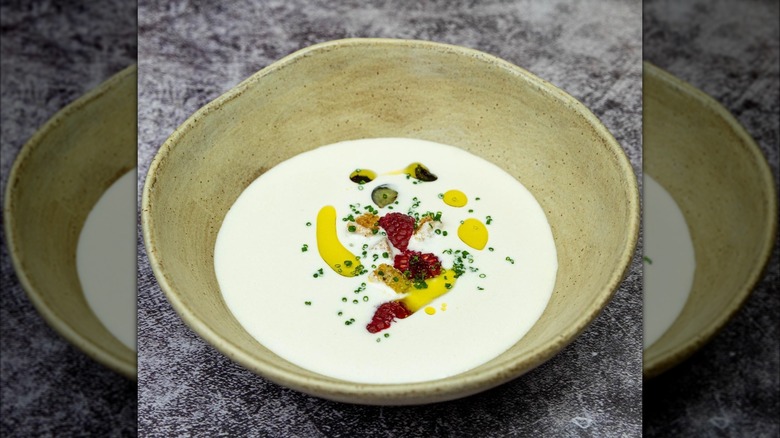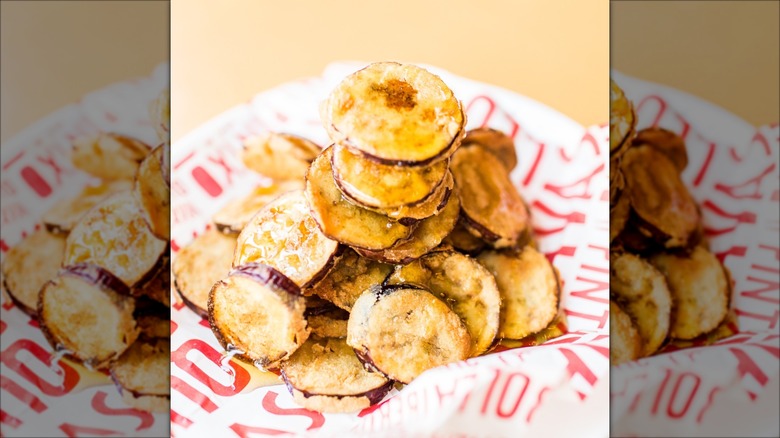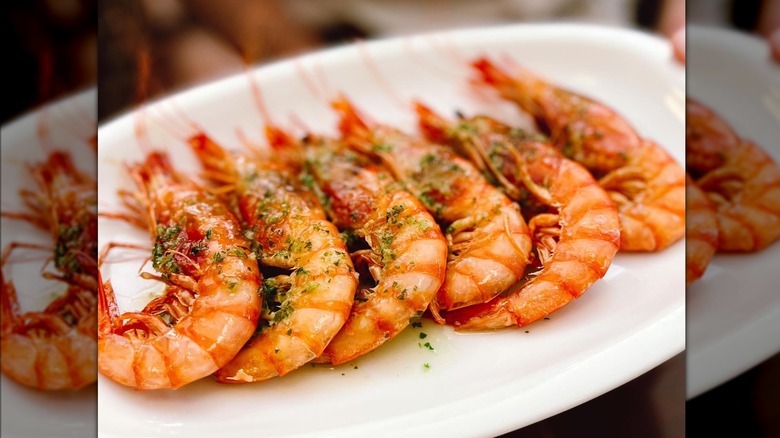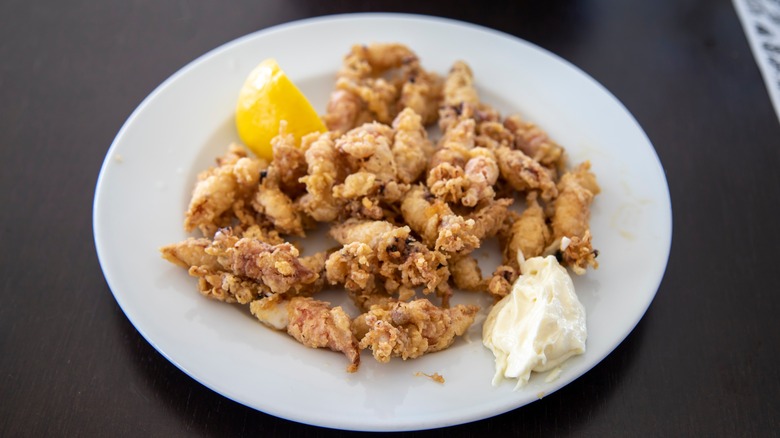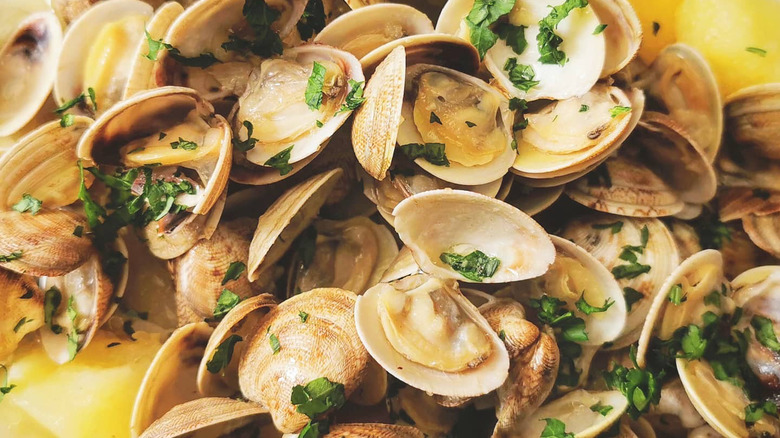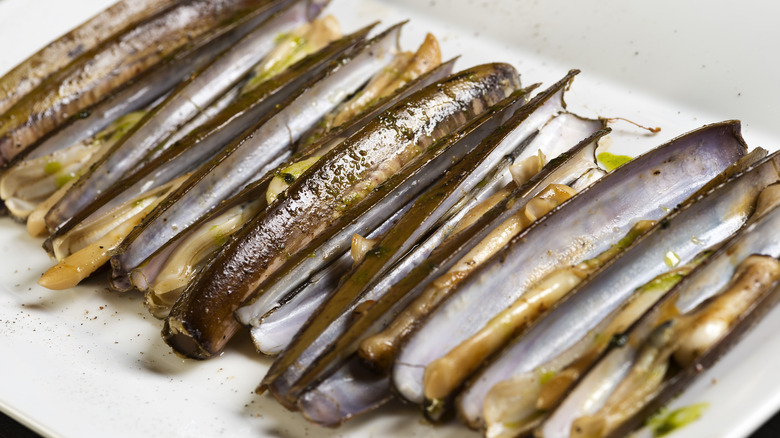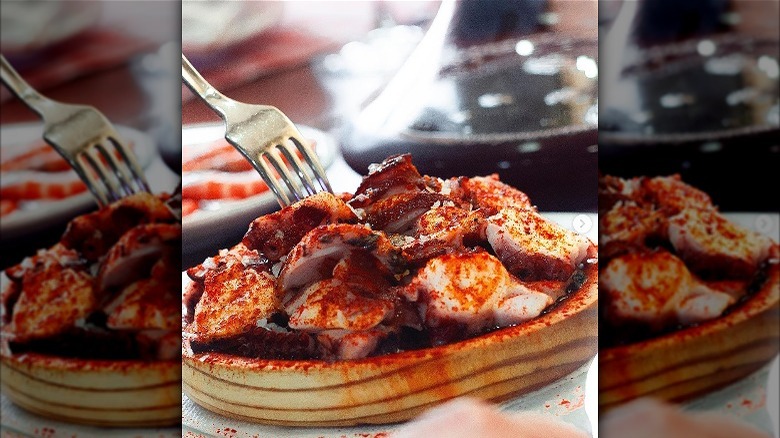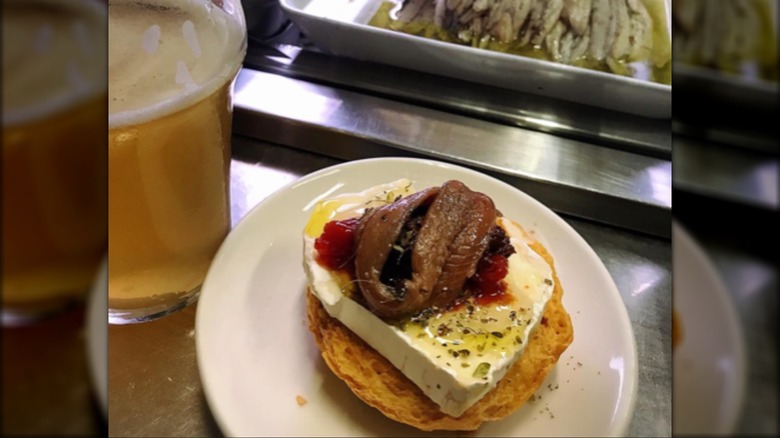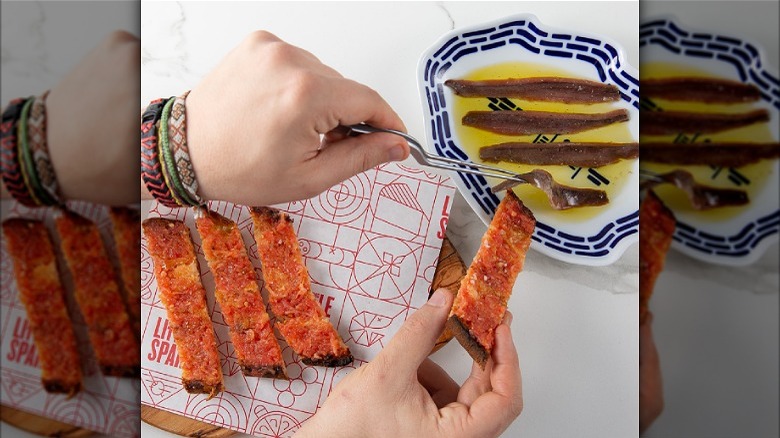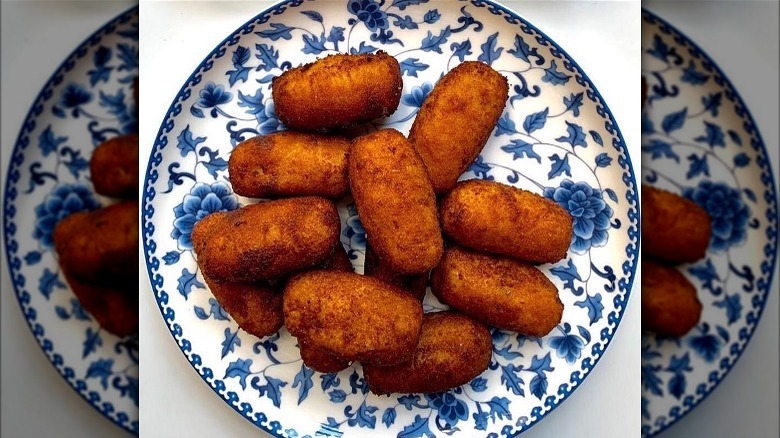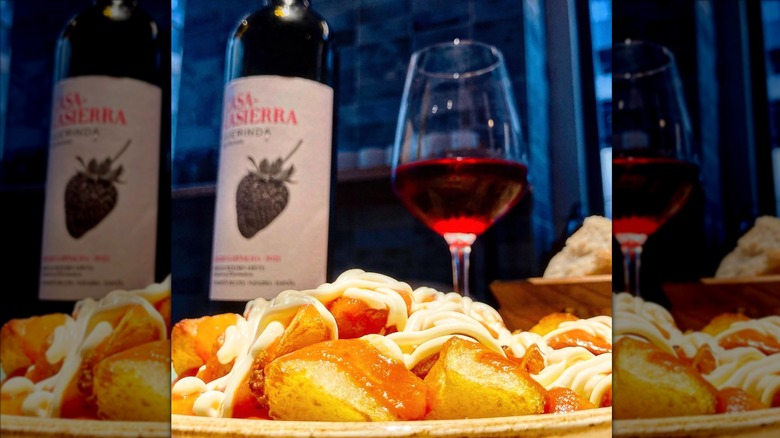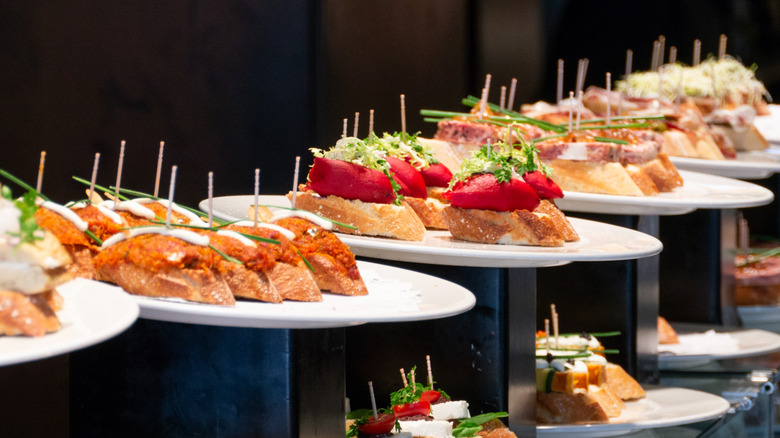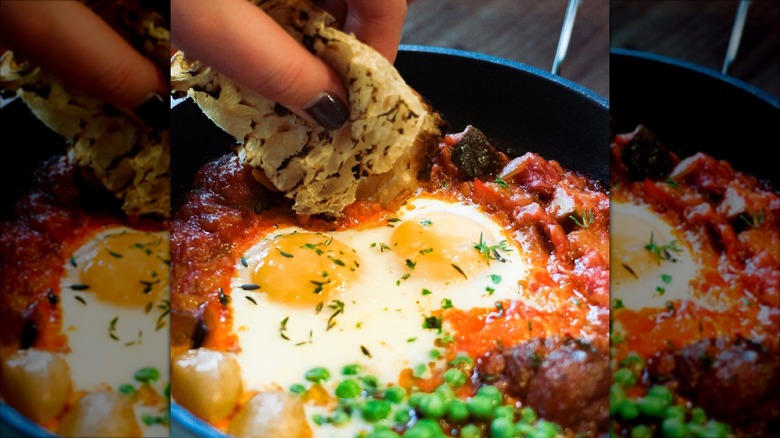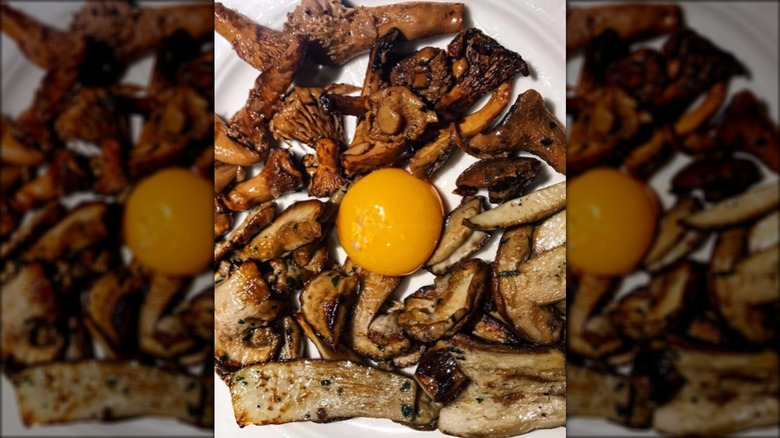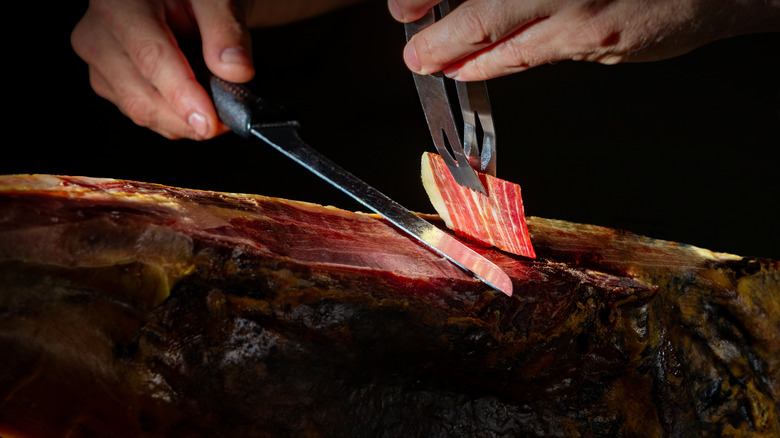15 Spanish Tapas You Need To Try Before You Die
As food traditions go, tapas are one of the most illustrious in the world. Tapas, according to On The Line, tick all the trendy dining boxes, including a relaxed atmosphere and lots of food options. Not only did the Spaniards share their small plate dining concept, but also the electric energy and community it encourages.
With so much of the tapear world out in the open, the nuances are easy to overlook. Outside Spain, limited perceptions of what tapas are and can be persist, but in truth, categorizing and judging them all is a nigh impossible task.
Propelling through crowded entrances at local taperías or tascas is a religious activity, but knowing some key tapas cues will get you far (via Lonely Planet). Dining before 8 p.m. — 9 p.m. in summer — is considered downright unruly. Racing to the bar (throwing elbows if needed) is often the only way to successfully place an order. And in some places, the only acceptable way of clearing the table may be swiping paper napkins and toothpicks to the ground.
Curious about the world of these small yet mighty plates? These 15 tapas are just the start of your adventure, but hopefully, they will give you a well-earned sense of urgency to explore a limitless world of delectable small plates.
Ajo blanco
Like its cousin, the well-known gazpacho, the soup known as ajo blanco is also chilled. It was created by modest southern fieldworkers long before tomatoes were introduced to the Mediterranean (via "Tapas: A Taste of Spain in America"). Early ajo blanco was made with just bread, water, and garlic, but after the Moors brought almonds to southern Spain in the 7th century, those became an obvious addition (via BBC). According to Smithsonian Magazine, tomatoes didn't hit Europe until the 16th century, which means ajo blanco should rightfully get credit for today's gazpacho cravings.
Essentially, ajo blanco is a savory almond milk spiked with fruity olive oil, a splash of sherry vinegar, and a hint of garlic (via "Tapas"). Along with peeled almonds, bread, and water, the ingredients are blended until it turns into a bright, white soup that's then strained. Left behind is a silky, unctuous liquid with a delightful viscosity. A hint of garlic adds a savory note without overwhelming bite, while the vinegar cuts through the fatty almond base and commonplace green grapes add a hint of sweetness.
Berenjenas con miel
For those who haven't been to southern Spain or managed to get a glimpse of the region's Moorish influence at stateside tapas bars, fried eggplant with honey might seem odd. But approach this dish of crispy fried eggplant drizzled in sweet, dark honey as you would any other sweet and savory treat, and you surely won't regret it.
Berenjenas con miel is native to Andalusia, and particularly popular in Córdoba, per TasteAtlas. Nearly every restaurant menu offers these crispy, honey-coated eggplant pieces. Some are cut into sticks while other draw on an eggplant's naturally round shape. Traditionally, a dark sugarcane syrup known as miel de caña is used, adding sweet molasses notes to the crispy eggplant.
José Andres serves a popular version of berenjenas con miel at his restaurant, Jaleo (via Vegetables Unleashed). Andrés soaks Japanese eggplant slices in buttermilk to remove some of the fruit's natural bitterness and then dredges the pieces in flour. After frying, he drizzles the crispy eggplant slices with local honey and sprinkles Maldon sea salt and fresh lemon zest on top. If you still aren't convinced, head to Yelp to check out rave reviews — one diner compares Andrés' interpretations of berenjenas con miel to a Krispy Kreme donut.
Gambas a la plancha
Gambas a la plancha is a culinary mystery. How can something so simple, using just two ingredients, create something so good you won't ever need to eat a shrimp any other way? The plancha, a flat metal heating surface, is where the true magic takes shape, along with good quality shrimp (via Williams Sonoma). While anything can be cooked a la plancha to acquire irregular char marks and a gentle smokiness, gambas (shrimp) are the pinnacle of la plancha cooking.
First, the plancha is heated, then coarse salt is sprinkled on the surface. Not only does the salt help season the shrimp, but it also maintains their sinfully delicious sweetness and juiciness. Some preparations go the extra mile with a liberal drizzle of extra-virgin olive oil — the lack of heat allows the oil's natural flavors to shine through.
At the table, removing the salted peels with your fingers to unveil succulent pink shrimp is the ultimate culinary reward. Sucking the flavorful shrimp head before moving on to the next is encouraged, too. Try substituting a hot cast iron skillet or heavy-duty pancake griddle at home to achieve similar results.
Chopitos
These small fried squid go by many different names, but their popularity in Spain remains untouched. They are the perfect tapa — fried, shareable, and consumed with our hands. Chopitos fritos should arrive piping hot and ready for one chosen diner to do the honor of squeezing fresh lemon juice over the crispy fried chopito nooks and crannies. Per Fascinating Spain, chopitos are a favorite throughout the nation, although Andalusia and Madrid maintain a particular fondness.
Each batch of chopitos starts with well-cleaned fresh baby squid (via New York Times) that are tossed in salt and flour, then fried until golden. Meanwhile, chipirones fritos utilize the same crustacean. Chirpirones are also baby squid (via Mercado Little Spain) but may take the chipirones name depending on the region. In fact, a 2020 Twitter debate brought chopitos and chipirones confusion to a head. 20Minutos reported on a viral trend that had Twitter users matching chipirones, chopitos, and puntillas word usage to people's place of residence. But, no matter what you call them, they're a can't-miss tapa experience.
Chirlas al ajillo
Despite living in a fairly integrated food world, the truth is that access to seafood from foreign waters remains difficult for most of us to achieve. When it comes to clams, the bivalve world is far more vast than American supermarkets let on. Chirlas, another member of the bivalve family, are prepared all over Spain. Per Real Academia Española, chirlas are smaller than the average littleneck clam and have a smaller commercial fishery footprint than other varieties, despite being just as popular (via Pescaderias Coruñesas). The small bivalves live in the Mediterranean and Atlantic waters off European coasts, so we don't have many chirla sightings in the U.S.
Chirlas al ajillo is a specific dish prepared with these tiny clams in a sauce of garlic, lemon, paprika, and olive oil (via TasteAtlas). The clams are steamed in this aromatic sauce until they are fully open, allowing their salty liquor to melt into the garlic-infused olive oil. The meat is incredibly tender, and when all are sadly gone, a consolation prize of clam juices is ready for sopping up with some bread.
Navajas a la plancha
When tapas fandom hit the United States, razor clams gained acknowledgment. Ever since, razor clams have slowly gained popularity stateside, finding their way into American fish markets from nearby sandy shores. A bivalve, per Great British Chefs, razor clams are unique in a few ways. First, the texture of the meat looks almost squid-like, with a tinted white color and firmer texture than other clam varieties. The meat is also sweeter and more delicate if cooked properly. Of course, the long shape is also distinct, the shell resembling a large razor blade.
Using these clams, navajas a la plancha is simple to make but extremely rewarding to eat. Properly cleaned razor clams (you don't want unwanted grit to ruin the moment) hit the flat metal plancha's radiating heat, the juice inside helping the clams steam and open up. A nice glug of extra-virgin olive oil, minced garlic, chopped parsley, and lemon juice is customary before serving. We think these are the only four ingredients sweet navajas could ever need.
Pulpo a la gallega
Evidently, seafood shortages do not exist when it comes to tapas. But let's take a step back from the bivalve family to fully appreciate the delicacy that is pulpo a la Gallega. Per National Geographic, octopuses have been a staple ingredient in Spanish cooking for centuries, but only recently is it hitting dining rooms all over the world.
Despite its newfound popularity, pulpo has always been a source of pride for Galicians. Pulpo a la Gallega — a Galician dish of tender, sliced octopus drowning in olive oil, smoked paprika, and salt over a bed of boiled potatoes — is served at tapas bars all over Spain, usually with toothpicks for piercing and dragging the chunks through the oil.
Galicians are so proud of their culinary heritage that, every August, the Festa do Pulpo (Octopus Festival) puts the ritualistic process of making pulpo a la Gallega on display for thousands of attendees. At the festival, you can watch cooks simmering whole octopi in giant copper pots (which supposedly impact the flavor), slicing the octopus into smaller pieces, evenly arranging them on wooden plates, and serving it all with extra-virgin olive oil, pimentón, and flaky salt. If you happen to go, pay close attention to the long cook time and essential rest before slicing. It might be your only chance to glean some cooking tips from the best pulpeiros in the world.
Conservas
Conservas are not your average canned fish. Instead, conservas de calidad (quality tinned foods) is a Spanish delicacy, pre-packed with herbs, spices, aromatic vegetables, and olive oil and ready to eat the second they're opened. They don't have to be refrigerated, and unlike canned tuna in the U.S., you know exactly what you're getting when you open it (via TimeOut). Mejillones en escabeche is a great example. Shelled mussels are packed in tins with vinegar, olive oil, white wine, onions, and spices and can be eaten straight from the can (via TasteAtlas). Olives, razor clams, and calamari are just a few more varieties that can gain status with time in a tin.
Quimet & Quimet, a tapas bar in Barcelona, take advantage of flavorful and easy-to-prep conservas with a strategy they call "el arte de combinar las latas." Preserved fish, meats, and vegetable conservas are the creative backbone, but the skilled bartenders do all the technical construction. The result is remarkable tapa creations for patrons who brave the crowds in pursuit of delicious creations (via Condé Nast Traveler). In the U.S., New York restaurant Maiden Lane takes inspiration from Spanish conserva tradition, selling some of the best imported tins (with only hand-harvested seafood) for well over $20.
Pan con tomate
You'll rarely come across a tapas menu that doesn't offer tomato toast. In its simplest form, pan con tomate consists of toasted bread, fresh tomato, extra-virgin olive oil, and salt and is eaten throughout the day — even for breakfast (via Los Angeles Times). In addition to hot coffee or refreshing glass of juice, tomatoes and a serrated knife are served alongside bread, olive oil, and salt, allowing for a customized experience.
This tapas dish is simple in theory but relies on excellent ingredients to achieve next-level results. A good bread base is essential for flavor, texture, and durability. Pan de cristal, a bread with remarkable airiness, is the crown jewel for pan con tomate, although any artisan crusty loaf will work well in its place (via La Tienda). The bread slices are toasted, then receive a liberal garlic rub and oil drizzle. Lastly, sweet tomatoes or tomato pulp glazes the bread. Because there is seemingly no limit to the stuff, even more extra-virgin olive oil is drizzled on top. The crisp bread soaks up the tomato juices while maintaining its sturdy grip, melting into beads of fruity olive oil and crunchy salt flakes. At tapas bars, sliced manchego cheese, whole cured anchovies, or jamón can accompany this treat.
Croquetas
Seafood isn't the only tapa making the rounds straight from the deep fryer. Croquetas, a breaded fritter packed with chicken, jamón, or bacalao (salt cod), are universally cherished all over Spain (via TasteAtlas). Croquetas are an instant crowd pleaser, just like a mozzarella stick disguising its gooey interior with a golden brown breadcrumb crust. Although they come from modest beginnings, the multistep process is elaborate and worth every second of effort (via New York Times).
The process starts with an extra thick béchamel sauce. Before the béchamel gets too thick, pieces of shredded chicken, other types of meat, or vegetables are folded in. Then, the mixture is chilled until firm enough to handle. After the mixture is cold, it's rolled into small cylinders and dredged in flour, egg, and breadcrumbs. The real fun starts when the oil reaches temperature, and after just a few minutes, the bitesize croquetas emerge golden brown with a semi-molten interior.
Patatas bravas
Of course, any dish that starts with fried potatoes is a frontrunner, but throw in two sauces — one creamy aioli and one sweet, tart, and spicy tomato — and all bets are off. Patatas bravas possess three essential components: fried potatoes, sweet and tangy tomato sauce, and garlic aioli. The potatoes go through two cooking phases. The first is a low and slow poach in extra-virgin olive oil, followed by a flash fry to get them crispy (via InsideHook).
After the potatoes hit the plate, you or a server can use a squeeze bottle to lay on the sauce, getting the ideal ratios of pillowy potato, sweet tomato sauce, and zingy garlic aioli. Soon, the real battle begins as hungry diners compete to snag the crispest potato piece with the most optimal sauce coverage. Surely, salty potatoes, sweet tomato sauce, and zingy garlic aioli is a bite to be had.
Montaditos
Everyone loves a sandwich, so this sandwich sampler of sorts is a nothing short of a must-try on tapas menus. Per Culture Trip, montaditos are essentially open-faced sandwiches. Although bread is naturally a montadito prerequisite, according to TasteAtlas, the toppings are figuratively endless. Montaditos have been eaten throughout Spain since the 15th century and are perhaps the very first sandwich in the country. At first glance, montaditos look like Basque-style pintxos, a cousin to tapas that features an identical bread base but utilizes a toothpick to hold the toppings in place. Essentially, all pintxos are montaditos, but not all motaditos are pintxos.
What makes montaditos so unique? Bread is a promising start, but the real opportunity lies in nigh-infinite topping possibilities. Some show off traditional slices of tortilla de patatas (via Instagram), while others feature creamy bacalao spreads (via Instagram) or just a simple piece of cheese or jamón for a savory bite.
Pisto manchego
In many tapas spots, Spanish vegetables are treated with the same care and precision as the finest Mediterranean seafood. They are never an afterthought, even if the produce in question is simply a plate of fresh tomatoes soaked in fruity olive oil, vinegar, and salt. Pisto manchego is no exception. While we're here, let's make it clear that pisto manchego lacks manchego cheese in any form. Yet, its brilliance doesn't leave us missing that cheese one bit.
Pisto manchego is a vegetable dish often referred to as Spain's version of ratatouille, although Spanish olive oil adds a unique richness (via "Toro Bravo"). In general, pisto manchego is less full of tomatoes than its French cousin. Although preparations can vary, a combination of ripe bell peppers, tomatoes, onions, eggplant, and zucchini are standard (via The Independent). Sometimes pisto is served on the chunky side, while other times it's pleasantly smooth. But the best form, to our minds, includes eggs (sometimes quail eggs) that have been poached within the flavorful vegetable mixture. Then, all that's needed is crusty bread to soak up those ripples of olive oil and runny egg yolk.
Hongos a la plancha
Mushrooms, known as bongos or setas, are served just about everywhere in Spain, perfumed with garlic and extreme amounts of olive oil. They can be sauteed, baked in the oven, or cooked on a hot, flat griddle.
Hongos a la plancha are a regional Basque delicacy worth the four-and-a-half-hour drive north from Madrid. Wild mushroom supplies vary, so no two plates look the same, although a garlic-infused olive oil and runny egg yolk center remain consistent (via The Baked Road).
Foie gras can be added to the dish, as its homeland is conveniently close to the French border. There is no overhyping the grandeur of this simple yet rich plate. Beloved chef Anthony Bourdain called hongos a la plancha a favorite of his (via The Baked Road). It's easy to see why: the seared, earthy mushrooms ooze with garlic olive oil, and the runny egg yolk center turns into a rich dressing. The dish even made the top 99 pintxos list, voted in by an esteemed committee of nearby Michelin-starred chefs (via Instagram).
Jamón
No tapas meal is complete without a plate of freshly carved jamón. Therefore, it seems only right to wrap up this tribute with one of Spain's most coveted products. Jamón enthusiasm is so strong that even declared vegetarians will receive repeated offers from proud Spanish carvers.
Jamón Ibérico de bellota is the cream of the jamón crop. Per the New York Times, jamón is made with Iberian pigs that feast on only premium acorns. Strict regulations require that only two Iberian pigs can inhabit one hectare of land, ensuring that there is ample room for the pigs to do their acorn feeding thing.
Later, the fatty legs are cured for up to 15 days and aged from 8 to 11 months. In taperías, jamón is carved to order, the translucent slices showing stripes of colorful cured meat and buttery fat. The cuts go quickly, of course, often served with slices of bread. Jamón also appears in other tapas dishes, including bacadillos, croquetas, and sautéed mushrooms.
